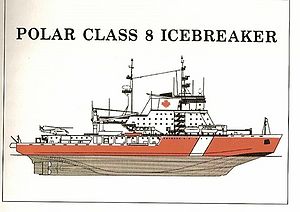Polar 8 Project
 Polar 8 design | |
| Career | |
|---|---|
| Operator: | Canadian Coast Guard |
| Cost: | C$700 million |
| Fate: | Project cancelled 1990 |
| General characteristics (as designed) | |
| Displacement: | 37,000 tons |
| Length: | 167 m (547 ft 11 in) |
| Beam: | 35 m (114 ft 10 in) |
| Draft: | 10 m (32 ft 10 in)–12 m (39 ft 4 in) |
| Ice class: | +100 A1 |
| Propulsion: | Diesel electric, 101,000 hp |
| Speed: | 15 knots (28 km/h) |
| Range: | 6,500 nmi (12,000 km) |
| Complement: | 100+ |
| Aircraft carried: | 2 helicopters, probably Sikorsky S-61 |
The Polar 8 Project was a Canadian shipbuilding project based upon a class of 167-metre, 101,000-horsepower, diesel-electric powered high endurance icebreakers (polar class PC 1) intended for the Canadian Coast Guard. The project was developed as a means to assert Canada's sovereignty in the Arctic Ocean. It commenced in 1985 but was cancelled in 1990 while still in the final design stage.[1]
The Polar 8 Project was proposed to Parliament in 1985 by the new Progressive Conservative administration of Prime Minister Brian Mulroney. It was Canada's direct response to the unauthorized transit through the Northwest Passage in summer 1985 by the USCGC Polar Sea, a United States Coast Guard icebreaker.
The Polar 8 Project was originally designed to be nuclear-powered, however this was subsequently down-graded to a conventional diesel-electric power plant. The ship would be equipped with two transport helicopters, 2 LST (auxiliary landing vessels), 4 life rafts, and possibly 2 hovercraft.
Project cancellation
The massive 1989 federal budget cuts saw funding for the Polar 8 Project reduced and eventually it was cancelled in 1990, only two months before construction was scheduled to begin. The ships were to have been built at Versatile Pacific Shipyards in British Columbia at a cost of $700 million CAD each.
The CCG had delayed critical modernization upgrades that had been planned for its Gulf-class icebreaker, the CCGS Louis S. St-Laurent during the late 1980s while the Polar 8 Project was underway. Following the Polar 8 Project cancellation, CCG funded the modernization overhaul and hull extension of the Louis S. St-Laurent in order to maintain a strategic presence in the Arctic Ocean. CCG has also purchased a former commercial icebreaker, the CCGS Terry Fox, during the late 1980s as a stop-gap measure.
Epilogue
- Arctic Patrol Ship Project
The federal government announced in 2007 that it would procure a fleet of 8 light icebreaker patrol ships for the Canadian Forces. The Arctic Patrol Ship Project is based on a Royal Norwegian Navy patrol boat design used in the Barents Sea with a polar class of PC 5; thus they will be significantly smaller and less capable than what was envisioned in the Polar 8 Project, which would have extended the already legendary capabilities of the Canadian Coast Guard's operations in the Arctic Ocean. Some media and political sources termed these new patrol vessels with their limited ice capability to be mere "slush breakers".
- Polar Class Icebreaker Project
The February 2008 federal budget announced a $720 million project to build a replacement for the CCGS Louis S. St-Laurent in FY 2017; an August 2008 announcement stated that the vessel's name was to be CCGS John G. Diefenbaker. Many political and media sources incorrectly called this new vessel a "Polar Class Icebreaker", however this is a misnomer since all vessels classed by a classification society as being capable of operating in sea ice must have a polar class which can range from PC 1 through PC 7. Since the CCGS Louis S. St-Laurent is classed PC 1, it is quite likely that the CCGS John G. Diefenbaker will be similarly classed.
It should be noted that the original $700 million per vessel pricetag of an icebreaker from the Polar 8 Project in 1985, when adjusted for inflation to 2008, would be approximately $1.3 billion, therefore it is quite likely that the CCGS John G. Diefenbaker will be a much smaller vessel than the Polar 8 Project envisioned, albeit larger than the CCGS Louis S. St-Laurent.[2]
See also
References
- Polar 8 project technical drawings.
- Polar 8 background information
External links
- Arctic Sovereignty - Arctic Patrol Vessels
- "Canada Icebreaker deal". New York Times. March 3, 1987. http://query.nytimes.com/gst/fullpage.html?res=9B0DE4D91439F930A35750C0A961948260&partner=rssnyt&emc=rss. Retrieved 2008-03-10.
- T.C. Pullen (September-October 1986). "That Polar Ice-breaker". 14. Northern Perspectives. http://www.carc.org/pubs/v14no4/5.htm. Retrieved 2008-03-11.
